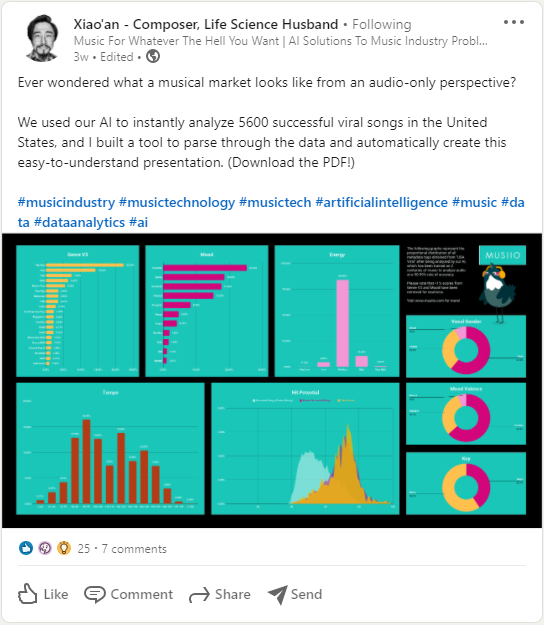The need for non-technical subject matter experts in data science
Known as Xiao’an — Composer, Life Science Husband on LinkedIn, his headline says “Music For Whatever The Hell You Want | AI Solutions To Music Industry Problems”. That got me really curious. What has a composer got to do with AI solutioning?
If you are curious like I am, check out the analytic blogs that he wrote for Musiio. Read on to understand more about how he got involved and what his involvements are in data science.
Huifang: Please tell us about yourself and what you do.
Xiao’an: I am a working composer. I ran an orchestra for five years in Boston and returned to Singapore last year. I’ve been creating music for games and commercials for the better part of the last eight years and run a small post-production company called Li & Ortega, which offers audio post-production services.
This year, I began working with the startup company Musiio, which uses AI to analyze music and create software solutions for the music industry.
Huifang: Being a composer and with no background in STEM, how do you get involved with AI?
Xiao’an: Plenty of non-engineers work in tech. Along with my music subject matter expertise, I’ve brought a broad network and general business acumen from years of bootstrapping a couple of my own businesses.
I was already familiar with the founders of Musiio and was curious to see what they had been up to. I had initially applied for a different position with them, which I didn’t get, but they offered me a position after I collaborated with them on a couple of blog articles.
Huifang: What role do you play in the development of AI solutions for music problems?
Xiao’an: I apply industry/real-world subject-matter expertise to the problems we are trying to solve, including the creation of new classifiers (including setting rules for rule-based classifiers) and the development of industry-specific insights through data analysis.
Huifang: What is it like to work with data scientists as a musician?
Xiao’an: I’ve found it to be quite an enjoyable thing. There are a lot of intersections between what musicians do and what physicists, mathematicians, or engineers do in the area of logic, patterns, and system design. So anyone who has a solid grounding in music shouldn’t have any problems talking to engineers.
Huifang: Can you tell us more about the AI projects that you have worked on so far?
Xiao’an: I came into the picture pretty late, so I’ve primarily worked on updates to existing classifiers.
One of these was our type classifier. It tells us whether something is music or something else, such as speech. Recently, we updated the software to include a lot of different categories such as stings, stems and drones. My input helped to remove the guesswork when defining the boundaries of what each of those meant.
Huifang: In one of your articles, you spoke about using AI to reveal the ideal countries or cities to launch your music. Could you tell us more about it?
Xiao’an: Chartmetric’s Trigger Cities concept shows that songs that break in particular cities exhibiting specific behaviour are more likely to go on and be globally successful. Through analysis of charting songs, we validated this concept by showing that the listening preferences of countries containing these trigger cities are more highly correlated with global listening preferences.
Huifang: How does the Hit Potential Algorithm work?
Xiao’an: The Hit Potential Algorithm analyzes a song and gives it a score between 0 to 100, which indicates how commercially successful it is likely to be. A low score does not indicate a “bad” song, just one that might have less broad commercial appeal.
A song on the low end of the spectrum could still be popular if we take into consideration contextual factors such as seasonality. For example, Chinese New Year songs will likely receive a low score from our Algorithm but do quite well in January and February in countries with large Chinese populations such as Singapore and Malaysia.
The 0–100 score still requires human interpretation in order to be maximally effective.
Huifang: Suppose a music publisher receives 100 songs and only listens to the top 50 highest rated songs, won’t they be missing out on the potential of the remaining songs?
Xiao’an: 100 is extremely conservative — publishers receive tens of thousands of songs and it is physically impossible to listen to all of them.
Most of these songs are already doomed to fall by the wayside. However, if the Hit Potential Algorithm was used as part of the screening process, A&R executives would be able to focus their time on those with the highest likelihood of success.
The Hit Potential Algorithm helps to give A&R departments more time to listen to these demos, versus manually sorting through 10,000 songs and spending only 5 seconds on each.
Huifang: How do we ensure diversity in the music industry if the A&R are going to listen to the top x% with the highest Hit Potential score and these are music with known trends that will do well?
Xiao’an: If there is a relative homogeneity across many of today’s pop hits, it is due to a prioritization of commercial success over musical innovation. This is not necessarily a criticism, simply an observation that businesses will do what they need to grow and survive.
AI has nothing to do with the lack of diversity in the music industry as these solutions have not been employed on a large scale yet. Perhaps we could arrest this trend toward homogeneity by hiring more diversely at the decision-making level.
I got to know what “Life Science Husband” meant. It’s all thanks to his “Life Science Wife” Danielle Duquette who taught him basic statistics, he was able to write those blogs like a data analyst.
AI penetrates almost every industry, including the art scene. As with all business domains, we will always need the subject matter experts to guide us on the right path for the technology that we are developing.
Stay on with us for part two of the interview with Xiao’An to understand more about the perspective of an artist towards AI.







